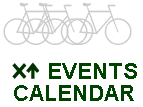Become an easy rider
amNew York (Page 18)
April 20, 2011
By Rebecca Brown
With spring struggling to burst forth, many New Yorkers’ thoughts are turning toward outdoor activities. If you’re ready to join one of the 230,000 cyclists who already are peddling the city’s 200 miles of marked bike lanes here are a few fundamentals to you get started.
RENT VS. BUY
Purchasing a bike is an investment, so if you’re just starting out, you’ll probably want to rent first. “Thoroughly test-ride a few models to get a feel for their differences and to ensure that you find the right fit,†suggested Hannah Borgeson, communications director of Bike New York. Speak with a pro and let them know the type of riding you plan to do and whether you’ll be on pavement or the elusive Manhattan dirt trail.
SET STARTER GOALS
Set a small goal for yourself as you start out, such as 30 minutes to an hour of cycling. As you get used to certain streets, memorize the location of potholes, barriers or intersections where you have to compete with foot traffic. This will enable you to get more comfortable riding in congested areas. Concentrate on your form (head up, shoulders and elbows relaxed) and mind the distance between your front wheel and riders ahead.
RULES OF THE ROAD
Intuitively, it may seem safer to ride against traffic, but it’s dangerous (and illegal). Don’t ride on the sidewalk, and used marked bike lanes and greenways when possible. In the city, it’s crucial that you keep your eye out for opening car doors. Hovering too closely to parked cars can put you in the “door zone,†so give yourself a few feet of cushion.
HYBRIDS AND MOUNTAINS AND FIXIES AND …
The types of bike to choose from can be overwhelming to a neophyte, so here’s a quick rundown:
• Mountain bikes: Great for rocky or gravel roads, but can be hard to pedal on pavement and don’t move as fast due to smaller and sturdier wheels.
• Road bikes: Give you the freedom to climb hills and tackle longer rides, plus they’re generally lighter than mountain bikes. They typically are available with either a drop-bar handlebar (more aerodynamic but can be uncomfortable for your back) or a flat-bar (allows you to sit upright).
• Hybrids: Are fast and easy to pedal. Borgeson recommends hybrids for urban bikers because they have flat handlebars and smooth tires.
• Cruisers and fixed-gear (“fixieâ€) bikes: Are popular, but they make climbing hills or taking long rides challenging because they only have one gear.
• Overwhelmed? Check out Bike and Roll (bikeandroll.com) — they offer a variety of rentals in Manhattan and Brooklyn and are a good resource for information.
EQUIPMENT
Never ride without a helmet — it’s required by law if you’re over 13. But that’s not all you’ll need. “Bikes must be equipped with a front white light, a rear red light, a bell, brakes and a saddle,†said Borgeson. You may also want to carry a U-lock, fix-a-flat supplies (Time’s Up teaches two weekly beginner’s bike-repair classes; go to timesup.org), and a Metro-Card in the event that you can’t fix a flat and need to haul your bike on the subway.
Places to pedal
• Governors Island reopens to the public on May 27 and has more than two miles of paths, gorgeous views of the harbor and no car traffic.
• Once you’re OK with the high volume of cyclists, runners and tourists, head on over to Prospect Park or along the scenic Hudson River Greenway.

